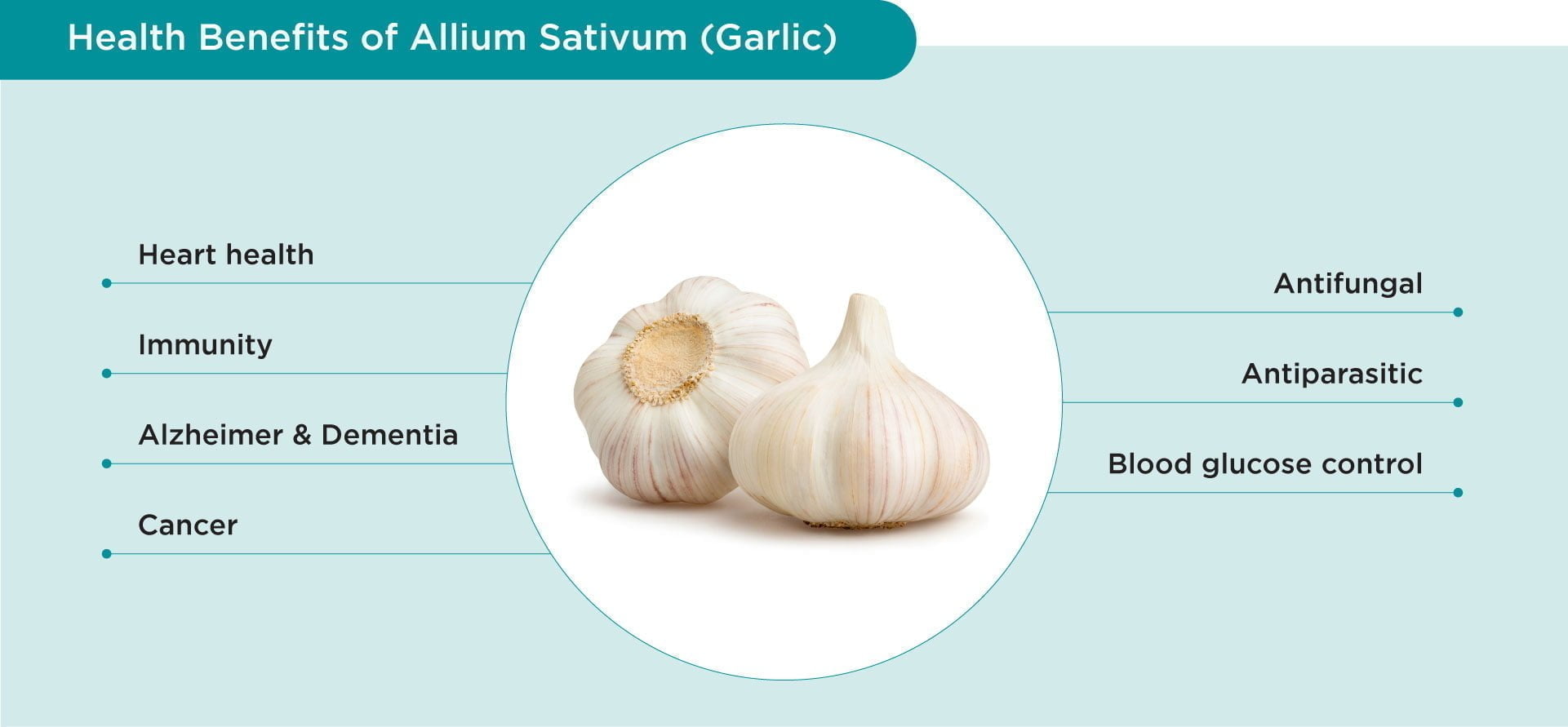Allium sativum (Garlic)

Allium sativum (Garlic)
Allium sativum, also known as Garlic, is an erect, bulb forming erect annual plant and is native to Central Asia. Garlics are cultivated and used around the world as an ingredient, vegetables, pickles or chutneys. Allium sativum is among the oldest cultivated plants used in folklore medicine for over 4000 years and is the most widely researched medicinal plant 1. In traditional Ayurvedic Medicine, Chinese Medicine, Islamic Medicine and Egyptian Medical Papyrus, garlic is described as an effective remedy for a variety of ailments including heart problems, lung disorders, common cold with headache, bites, worms, wounds and tumours 1.
Nutritional Facts
Allium sativum or Garlic contains many nutritional components, including 17 amino acids, more than 33 Organosulfur Compounds (OSCs), 8 minerals (calcium, potassium, magnesium, germanium, selenium, copper, zinc, and iron), vitamins (A, B1, B2, B3, B6, B12, C, D, E), and some enzymes (alliinase) 2. Allicin as the major biologically active component of fresh garlic contribute to the taste of garlic. Other principal compounds identified from Allium sativum are diallyl sulfide, diallyl disulfide, allyl methyl sulfide, diallyl trisulfide and garlicnin 1,2.
Published Health Benefits
1. Heart Health
Allium sativum has significant effects on lowering blood pressure, reducing serum cholesterol and triglyceride, inhibiting platelet aggregation and preventing plaque (fatty deposits) build up in the arteries 3,4.
2. Immunity
Allium sativum is loaded with antioxidants, which has a positive effect on the immune system in general to protect our body against all types of bacterial and viral attacks 2,3,4. It is also a good source of Vitamin C, B6, Selenium and Manganese, which are good immune boosters, and commonly used in preventing and treating colds and other infections.
3. Alzheimer and Dementia
Allium sativum contains powerful antioxidants that help improve memory by eliminating free radicals that cause oxidative damage, thus preventing Alzheimer’s Disease and Dementia 1.3.
4. Cancer
Bioactive organosulphur compounds of Allium sativum and allicin have been shown to exhibit anticancer activities. These bioactive compounds block the formation of carcinogens, reduce cancer cell proliferation and induce apoptosis to cancer cells. Studies suggested that garlic can effectively prevent and slow progression of colon, stomach, prostate and esophageal cancers 1,4.
5. Antifungal
Allium sativum extracts have been shown to inhibit growth of fungal disease against a wide range of fungi such as Candida, Torulopsis, Trichophyton, Cryptococcus, Aspergillus, Trichosporon and Rhodotorula species 1,3,4.
6. Antiparasitic
Garlic extract, Ajoene and allicin both exhibit antiparasitic activity against Entamoeba histolytica, Plasmodium falciparum, Babesia, Theleria, Trypanosoma brucei, and Giardia lamblia 1,3.
7. Blood Glucose Control
Allium sativum can help to regulate blood glucose levels and improve insulin sensitivity 4. Allium sativum is also a good source of Vitamin B6 and C. Vitamin B6 is involved in carbohydrate metabolism and Vitamin C plays a role in maintaining blood sugar levels.
References:
1. Alam, M. K., Hoq, M. O., & Uddin, M. S. (2016). Medicinal plant Allium sativum: a review. Journal of Medicinal Plants Studies, 4(6), 72-79. https://www.researchgate.net/publication/342379203_Medicinal_plant_Allium_sativum_A_Review
2. Foroutan-Rad, M., Tappeh, K. H., & Khademvatan, S. (2017). Antileishmanial and immunomodulatory activity of Allium sativum (Garlic): a review. Journal of Evidence-Based Complementary & Alternative Medicine, 22, 141-155. https://journals.sagepub.com/doi/pdf/10.1177/2156587215623126
3. Mikaili, P., Maadirad, S., Moloudizargari, M., Aghajanshakeri, S., & Sarahroodi, S. (2013). Therapeutic uses and pharmacological properties of garlic, shallot, and their biologically active compounds. Iranian journal of basic medical sciences, 16(10), 1031–1048. https://www.ncbi.nlm.nih.gov/pmc/articles/PMC3874089/
4. Bayan, L., Koulivand, P. H., & Gorji, A. (2014). Garlic: a review of potential therapeutic effects. Avicenna journal of phytomedicine, 4(1), 1–14. https://www.ncbi.nlm.nih.gov/pmc/articles/PMC4103721/


